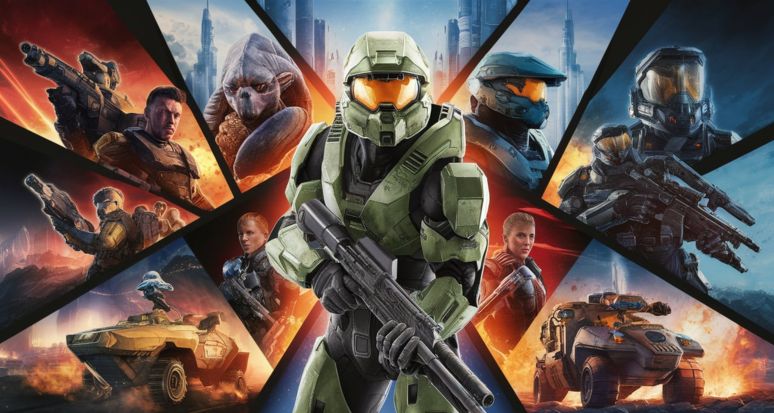“halo (2003) game icons banners
The world of gaming is rich with iconic titles that have left an indelible mark on the industry. Among these, Halo: Combat Evolved (2001) and its sequel, Halo 2 (2004), stand out as groundbreaking games that have defined the first-person shooter (FPS) genre. Released in 2003, the original Halo introduced players to a universe filled with epic battles, memorable characters, and a multiplayer experience that laid the groundwork for future online gaming. However, beyond the core gameplay mechanics and story, one of the often overlooked aspects of the Halo series is the visual identity created through its icons and banners. These elements have played a crucial role in building the game’s brand, fostering community engagement, and enhancing the overall player experience. “halo (2003) game icons banners
This article delves into the significance of icons and banners in Halo (2003), exploring their design, evolution, and impact on the gaming community. We will also look at how these visual elements have contributed to the game’s enduring legacy. “halo (2003) game icons banners
The Role of Icons and Banners in Gaming
Icons and banners are more than just decorative elements in video games; they are powerful tools that contribute to a game’s identity, user interface (UI), and overall player experience. In the context of Halo, these visual elements serve several key purposes: “halo (2003) game icons banners
- Brand Recognition: Icons and banners are often the first things players see when they launch a game. They help establish a visual identity that is instantly recognizable, contributing to the brand’s consistency across various platforms and media.
- User Interface: In-game icons are essential for navigating menus, understanding game mechanics, and providing feedback to players. Banners, on the other hand, are used to communicate important information, such as events, updates, and achievements.
- Community Building: Icons and banners often become symbols of community identity. For example, in multiplayer games like Halo, players may use specific icons to represent their clans or achievements, fostering a sense of belonging and pride.
- Aesthetic Appeal: Well-designed icons and banners enhance the visual appeal of a game, making it more enjoyable for players to interact with. They contribute to the overall atmosphere and theme of the game. “halo (2003) game icons banners
The Design Philosophy of Halo (2003) Icons and Banners
The design of icons and banners in Halo (2003) reflects the game’s broader aesthetic and thematic elements. Halo is set in a futuristic, science-fiction universe, and its visual design draws heavily from military, technological, and alien influences. The icons and banners within the game are no exception, as they are crafted to resonate with the game’s setting and tone. “halo (2003) game icons banners
- Minimalism and Clarity: One of the key design principles for the icons in Halo is minimalism. The icons are typically simple, with clear lines and shapes that are easy to recognize at a glance. This is especially important in an FPS game, where quick decision-making is crucial.
- Symbolism and Meaning: Each icon and banner in Halo is imbued with symbolism that reflects its in-game purpose. For example, weapon icons are designed to resemble their real-world or fictional counterparts, while achievement icons often include visual cues related to the accomplishment they represent. “halo (2003) game icons banners
- Consistency: The design of icons and banners in Halo is consistent with the game’s overall art direction. This consistency helps to create a cohesive visual experience, reinforcing the game’s identity and making it easier for players to navigate the UI.
- Cultural and Historical References: The Halo series is known for its rich lore, which draws from a variety of cultural, historical, and mythological sources. Some icons and banners incorporate these references, adding an additional layer of depth for players who are familiar with the game’s backstory. “halo (2003) game icons banners
Evolution of Icons and Banners in Halo: Combat Evolved (2003)
The original Halo: Combat Evolved (2001) set the stage for the series, but by 2003, the game’s design elements had begun to evolve in response to player feedback and technological advancements. This section explores the changes and developments in the design of icons and banners during this period. “halo (2003) game icons banners
- Refinement of the UI: As Halo gained popularity, the developers at Bungie began to refine the game’s user interface to improve usability and player satisfaction. This included updates to the design of icons and banners, making them more intuitive and visually appealing.
- Introduction of Multiplayer Icons: The 2003 updates to Halo included the introduction of new multiplayer icons, which allowed players to customize their in-game experience further. These icons became a key part of the Halo community, as players used them to represent their identities in online matches.
- Expansion of Icon Sets: With the growing popularity of Halo, Bungie expanded the range of icons available in the game. This included new weapon icons, vehicle icons, and achievement icons, each designed to enhance the gameplay experience and provide players with a greater sense of accomplishment.
- Adapting to New Platforms: By 2003, Halo had been ported to several platforms, including PC. The design of icons and banners had to be adapted to suit different screen resolutions and input methods, ensuring that the game remained accessible and enjoyable across all devices. “halo (2003) game icons banners
Iconography in Halo: Weapons, Vehicles, and More
One of the most memorable aspects of Halo (2003) is its extensive use of iconography to represent the game’s vast array of weapons, vehicles, and other in-game elements. These icons are not just functional; they are also an integral part of the game’s visual identity. “halo (2003) game icons banners
- Weapon Icons: The weapon icons in Halo are designed to be immediately recognizable, even in the heat of battle. Each weapon has a distinct icon that reflects its design and function. For example, the iconic M6D Magnum Pistol is represented by a simple silhouette of the weapon, while the energy sword is depicted with a stylized, glowing blade.
- Vehicle Icons: Vehicles play a significant role in Halo, and their icons are equally important. The Warthog, Ghost, and Banshee are just a few of the vehicles with distinctive icons that help players identify them quickly. These icons are often used in the game’s HUD (Heads-Up Display) and map screens to provide players with vital information during gameplay. “halo (2003) game icons banners
- Power-Ups and Equipment: Halo also features various power-ups and equipment that players can use to gain an advantage in combat. Each of these items has a unique icon that conveys its purpose, whether it’s the overshield, active camouflage, or health pack. The design of these icons often includes visual cues, such as color and shape, to indicate their effects.
- Multiplayer Icons: In multiplayer mode, icons take on an even more significant role. Players can choose from a variety of emblems to represent their identities, and these emblems often become a source of pride and recognition within the community. The customization options for these icons are vast, allowing players to create a unique identity that reflects their personality and playstyle. “halo (2003) game icons banners
Banners and Their Impact on the Halo Community
Banners in Halo serve as more than just decorative elements; they are symbols of achievement, status, and community within the game. This section explores how banners have influenced the Halo community and contributed to the game’s lasting appeal.
- Achievement Banners: One of the most common uses of banners in Halo is to represent player achievements. Whether it’s completing a campaign on Legendary difficulty or winning a certain number of multiplayer matches, these banners serve as a visual representation of a player’s skill and dedication. The sense of pride that comes from displaying these banners is a significant motivator for many players. “halo (2003) game icons banners
- Event Banners: Bungie has hosted numerous in-game events over the years, many of which include exclusive banners as rewards. These banners often become highly sought after, as they are only available for a limited time. Players who participate in these events and earn the banners can show them off to others, creating a sense of exclusivity and prestige.
- Clan and Team Banners: In the multiplayer community, clans and teams often create custom banners to represent their group. These banners are displayed on player profiles, in-game, and on community forums, fostering a sense of unity and camaraderie among members. The design of these banners is a point of pride for many clans, as it reflects their identity and values.
- Seasonal and Thematic Banners: Over the years, Halo has introduced a variety of seasonal and thematic banners that players can earn through gameplay. These banners often tie into broader story arcs or themes within the game, providing players with a sense of connection to the ongoing narrative. For example, a banner featuring the Flood, a parasitic alien species in the Halo universe, might be tied to a special event or campaign mission involving that enemy. “halo (2003) game icons banners
The Legacy of Halo’s Visual Elements
The icons and banners of Halo (2003) have left a lasting legacy, not only within the Halo franchise but also in the broader gaming community. Their impact can be seen in several key areas: “halo (2003) game icons banners
- Influence on Future Games: The design principles established in Halo (2003) have influenced the development of icons and banners in subsequent Halo games, as well as in other FPS titles. The emphasis on clarity, consistency, and symbolism has become a standard in the industry, with many developers looking to Halo as a model for creating effective visual elements.
- Merchandising and Marketing: The iconic symbols of Halo have transcended the game itself, becoming a part of popular culture. The Master Chief’s helmet, the UNSC logo, and the Covenant insignia are just a few examples of Halo icons that have appeared on merchandise, in marketing campaigns, and even in fan art. These symbols have helped to build Halo into a global brand, recognized by gamers and non-gamers alike. “halo (2003) game icons banners
- Community Engagement: The ability to customize and display icons and banners has fostered a strong sense of community among Halo players. This sense of belonging has contributed to the game’s enduring popularity, as players continue to connect with one another through shared experiences and visual symbols.
- Aesthetic Inspiration: The visual design of Halo has inspired countless artists, designers, and creators. The game’s icons and banners, in particular, have been a source of inspiration for those looking to create their visual language in other media, from video games to graphic design. “halo (2003) game icons banners
Conclusion: The Enduring Appeal of Halo’s Icons and Banners
The icons and banners of Halo (2003) are more than just visual elements; they are a vital part of the game’s identity and legacy. Through their design, these symbols have contributed to the game’s brand recognition, enhanced the player experience, and fostered a sense of community that has endured for over two decades. “halo (2003) game icons banners
As we look back on the history of Halo and its impact on the gaming world, it’s clear that the game’s icons and banners have played a significant role in shaping its success. Whether you’re a longtime fan or a newcomer to the series, these visual elements are a reminder of the creativity, innovation, and passion that have made Halo a beloved part of gaming history.
In the end, the enduring appeal of Halo’s icons and banners lies in their ability to connect players to the game, to each other, and to a larger community that spans the globe. As the Halo series continues to evolve, these symbols will remain a testament to the game’s rich legacy and its place in the pantheon of gaming legends.











Post Comment